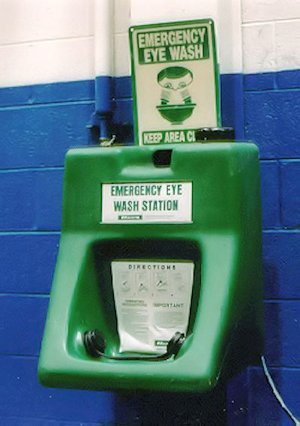Eye Wash Stations
Eye wash stations are required to be available to employees anywhere that potentially harmful corrosive materials are present, such as caustic soda. The stations can be hand-held bottles or permanent fountain-type wash stations.
Emergency Eyewash Station

- Units should be easily accessible and near work areas. Stations should be mounted off the ground or floor and covered if in an area where mud and chemicals could damage them.
- There should not be anything hanging on the station or obstructing it.
Locations
Write the location for each station on the form.
- Check to ensure the location is in close proximity to chemical handling areas and readily accessible in time of emergency. Regulations vary on how close the station should be to work areas, but ANSI specifies 10 seconds or about 55 feet from the hazard.
- Verify that the location of the eye wash station protects the unit from normal rig operations and the environment, and provides easy access.
- If located where mud, dust, or chemicals can contaminate the eyewash station, check that a cover is placed over it to protect it and is easy to remove in an emergency.
Type
The type of station should be written on the inspection form, for example "15 minute flood" or "hand held bottle".
Nameplates
- Check that the eye wash unit has a nameplate that faces outward, is clear and easy to read, and includes operating instructions.
Seals
- Check that the condition of the seal to see if the unit has been used or damaged. If the seal is broken, the unit must be fully serviced and resealed.
Knowledge Check Choose the best answer for the question.
1-10. According to ANSI, how close to a hazard should the eye wash station be positioned?
You forgot to answer the question!
